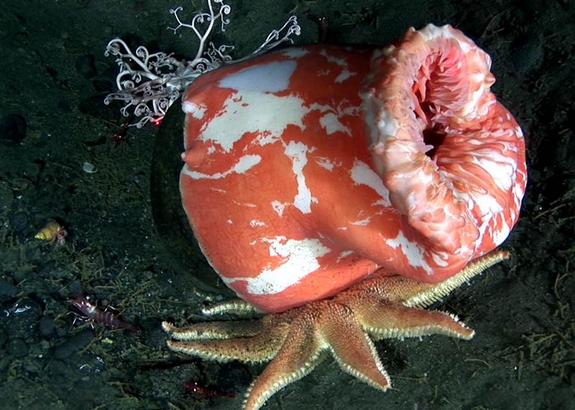Bering Sea Hope Spot on the Edge
May 4, 2014
One Small Step forward for the Bering Sea Canyons Hope Spot, Two Giant Steps Back!
It has been 10 months since the North Pacific Fishery Management Council indicated that they were willing to consider protections for the Bering Sea Canyons Hope Spot. In April, at the end of long week of Council conversations, they took their next, patiently awaited action on the canyons. While the Council did begin the process to consider management measures to protect coral habitat, they dealt a serious blow to protections by simultaneously dropping Zhemchug Canyon (the largest underwater canyon in the world) and all parts of the ecologically essential shelf-break (Green Belt) off the table.
Moving forward, the Bering Sea Canyons policy process will be limited to considering protections for significant concentrations of deep-sea corals in Pribilof canyon, period. Beyond that, they will wait until the results of new photographic research is submitted to the Council, expected in October 2015, before choosing any potential alternatives.

Credit: © Greenpeace / John Hocevar
This is the second time the NPFMC has given a tiny bit of ground on the Canyons, while simultaneously cutting the ecosystem off at the knees – limiting the scope of the area that will be considered. At the Juneau meeting last June they casually dropped the word “sponge” from their motion to move ahead. They have been decisively silent on the matter.
Mission Blue partners at Greenpeace, along with a coalition of stakeholders and NGOs continue to raise the issue of sponges. The NPFMC has simply ignored the science on the value of sponge habitat, as well as the public input urging them to walk their talk on ecosystem management.
In fact, the Council has heard directly from over 135 thousand individuals, nearly 100 Seattle businesses, a broad coalition of tribal organizations and conservation groups with millions of members, and some of our nation’s largest supermarket chains including Safeway, Trader Joe’s, SuperValue, Hyvee, and Ahold USA.
None told the NPFMC to take Zhemchug, the “Grand Canyon” of the Bering Sea, off the table. All of these stakeholders stressed the need to set aside a portion of the highly productive shelf-break, including these two canyons where Greenpeace submersible expeditions have confirmed the presence of critical coral and sponge habitat that supports the ecosystem and its productive fisheries.
The Bering Sea Canyons were named the 19th Hope Spot at IMPAC3 in October of last year. We are continuing to work with our partners and other stakeholders to create a sanctuary in this vital place that is a key area of support for the heart of our blue planet. The Bering Sea supports one of the world’s most productive fisheries, accounting for more than 50 percent of U.S. fish and shellfish catches.
While this may seem like a discouraging turn of events, we believe there are more hopeful chapters to be written in the campaign to protect the rich and ancient underwater worlds of our Bering Sea Canyons Hope Spot.
By Jackie Dragon, Senior Ocean Campaigner, Greenpeace and Deb Castellana, Mission Blue







